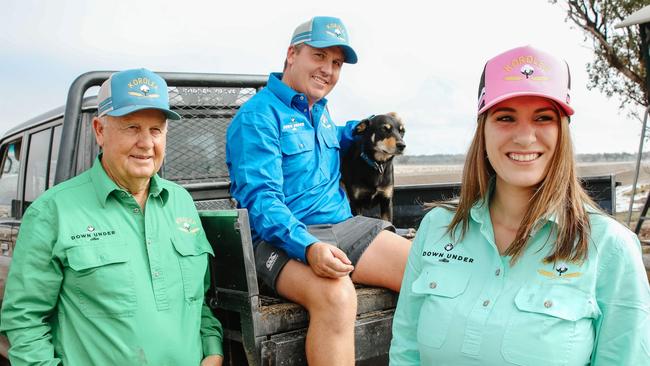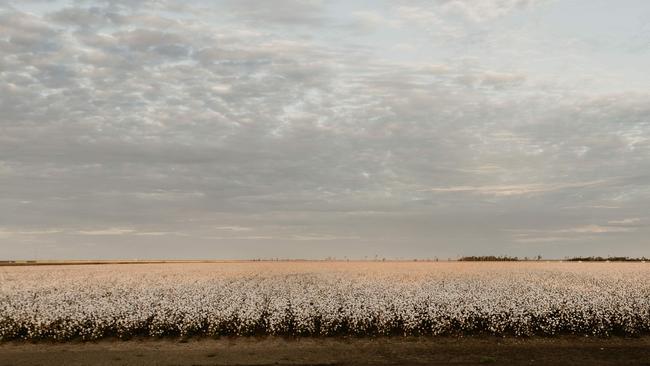Down Under Cotton: QLD’s Newell family supplying Aussie tampon cotton
Looking outside the square for new opportunities has paid dividends for a Queensland cotton growing family.
The Newell family has never been afraid to take a chance on new ideas, concepts and innovations.
They even moved interstate in the 1970s to improve and progress their farm business.
A bad drought at the time prompted Rob and Jan Newell to sell their dryland cereal farm at Sea Lake in the Mallee, and head north to more secure irrigation country in Queensland. They settled on a 250ha cotton property at Goondiwindi, where irrigation was just starting to develop, pumping from the Macintyre River.
It was a risk but the well-planned leap of faith allowed them to expand and grow their farming operation.

Their ability to remain open-minded has more recently led them down the regenerative agriculture path, which Rob and Jan, their son Andrew and daughter Kathy, believe will pay dividends in reduced input costs at a time when costs of production have skyrocketed.
They also now directly supply Australian company Down Under Cotton with enough bales each year to produce its feminine hygiene product, the first tampon made from 100 per cent Australian cotton.
CHANGE FOR THE BETTER
The Newells farm 2500ha of which 1750ha is irrigated and the remainder grazing country. They grow 1000ha of cotton each year when water is available with an additional 750ha in fallow or cover crop.

“The last couple of years we have looked more into the regenerative agriculture and not leaving the ground fallow so having something continually growing,” Andrew said.
Cover crops used for the rotation include mixed species of barley, vetch, field peas, radish and canola.
“Dad isn’t afraid of trying something new. He thought with input costs and improved soil from microbes and nutrition there had to be something better,” Andrew said.
“The last six years we’ve dipped our toes into the regenerative side of things but in the last few years we’ve really started to do a few more trials and thinking outside the box on how to do things. It’s possibly a little bit early to see much difference in results but we feel that we are on the right track. It’s a five-year process to really see some changes.”
NEW THINKING
Andrew said the change of mindset required to manage the farm differently was not easy and the concepts involved a great deal of learning along the way. Unusually wet seasonal conditions had also made comparisons with old and new management techniques difficult in the past few years.
In the 43 years the family has been at Goondiwindi, they have never seen so much water in the river.
“Normally you might have a flow or two in the river and we’ve had 12 flows in the river in the last 12 months,” Andrew said. “We are trying to do the cotton pick at the moment but we are struggling with the constant showers.”

Planting is conducted over a three-month period from terminating the cover crop to getting the country hilled up, fertilised, shaped and consolidated before planting in October. In the past when planting, the Newells would run water down furrows to keep it clean of weeds.
“Our thought process has changed now to weeds aren’t bad,” Andrew said.
“We need to have some form of cover. Last season we did a trial of some barley on the prepared country to give the ground cover until we planted the cotton. We are currently picking the paddock at the moment and it’s a mixed bag but we have things to improve on and how to do it better for next season.
“This year we were tied up with some cereal harvest because we had minimal cotton grown the previous year so we had a lot of spare country and our focus wasn’t really on the planting.
“The coming season we have plenty of water so we’ll be focusing on cotton instead of cereal. We’ll start with different timings of management and look at whether we need a mix of a few more seed varieties in the cover too.”
ROLLING AWAY FROM SPRAY
The Newells shy away from the term organic, preferring regenerative as it provides the freedom to find alternative methods while still being able to use conventional options if necessary.
They are working to reduce their use of sprays and chemicals through alternative methods including using a crimper roller.
“We have used pre-emergent sprays in the past but our thought process is changing and we are looking into a crimper roller, which is a round roller that has little bars in it that crimps the stems of the plants and kills it that way,” Andrew said.
“There are lots of YouTube videos about them and we’ve talked to a few people who have used them over time so we are looking to take the next step and purchase or build a machine ourselves. It will be a very important tool in the future.
“We are also starting to do a lot more leaf samples and seeing where the nutrition is in the crop and looking more into foliar sprays of fertiliser or applying fertiliser as needed rather than as a bulk pre- or post-planting application,” Andrew said. “This will help increase efficiencies in those areas.”

Another major change in management has been incorporating cattle into the enterprise, which the Newells have never had before.
Grazing country has been agisted out in the past but given strong livestock prices and their regenerative focus, the Newells have initiated a self-replacing herd of 100 Speckle Park breeders.
“Our aim is to increase the herd greatly because with the regenerative management we will run the cattle on the cover crops with the cotton to put the manure on the ground instead of us purchasing manure from a feedlot and spreading it on,” Andrew said.
HARVESTING EFFICIENCIES
Rain in crop helped the intervals of irrigation for the Newells this year but they normally average seven to eight megalitres of water for the season. Moisture probes guide water applications, which can range from once every seven to 14 days.
Harvest starts in April and cotton is ginned at Midkin, north of Moree, NSW, with prices currently reaching more than $900 a bale compared to about $500 previously.
“It’s shaping up to be one of our best seasons. The quality hasn’t been too bad. The early crop quality was excellent and the later crop has some downgrading but, considering the rain, it wasn’t too bad,” Andrew said.
Major costs for the Newells are diesel, fertiliser and herbicides, which they aim to reduce with their regenerative methods to become more profitable.
“If we don’t have to work the country to control the weeds as much, then we will have less operations on tillage and tractors, reduce machinery costs and reduce the fertiliser and herbicides to applying when needed,” Andrew said.
“By not keeping everything bare fallow we want to ultimately increase the microbes and carbon in the soils and have the soils healthy and living again. We are already finding some worms starting to come back into the country so if we can promote those, they are the way to go.”
Andrew said their key to remaining viable was to reduce inputs and increase yields.
“We focus on our gross margin and ultimately for us it’s finding a way to do it so that the soil benefits,” he said.

DOWN UNDER COTTON FIRST
When young Brisbane-based entrepreneur Kimberlee Coskun discovered most tampons were made with synthetic fibres or cotton sourced from overseas, she began searching for a more sustainable and healthier option.
“I reached out to a cotton grower at Goondiwindi to find out more about the way Australian cotton was grown and was excited to be given the opportunity to visit their farm and speak with the grower direct,” Kimberlee said.
That meeting was with Rob Newell and set the wheels in motion to launch Down Under Cotton last year, Australia’s first tampon made with 100 per cent locally grown cotton fibres and full traceability from paddock to product.
“We launched converting only one bale into tampons and now we have a larger second batch underway from the 2021 cotton harvest and hope to expand our distribution and enter grocery retailers,” Kimberlee said.

It has taken six years of research and liaison with manufacturers and while the tampons are not currently made in Australia due to the prohibitive cost of buying machines, it is the goal.
“In 2017 we visited a company in Zurich, Switzerland, which is the only manufacturer of tampon machines in the world. The cost is $2 million for the machine alone and the full set up was $4 million, which is not the kind of money most people have when starting a business,” Kimberlee said.
“In the meantime we have put in place a fully traceable production line that follows our Aussie cotton using the bale identification number, which travels with the cotton from paddock to product.”
The Newell family and the Australian cotton industry has been very supportive of the business venture.
“I’ve had many times that I could have given up due to the complications of manufacturing,” Kimberlee said
“But Rob has always believed in me and offered great advice. He not only grows our cotton but is my business mentor. His outlook on life and positive attitude is not only inspiring but very motivating.”
Andrew said Down Under Cotton was an important initiative to promote locally grown cotton.
“I think it has got a good future. Australian cotton has a good reputation so once she gets a stronghold on the market, it can go anywhere,” he said.




